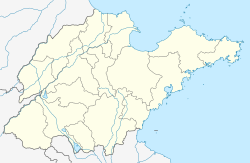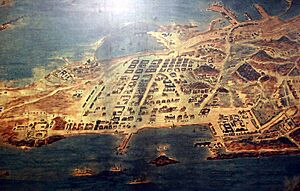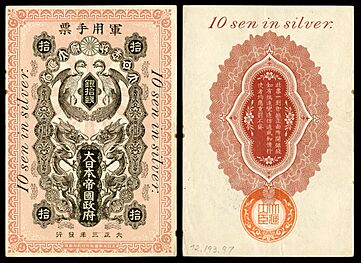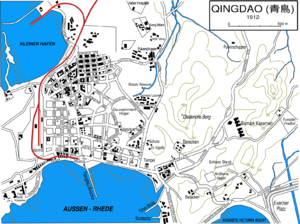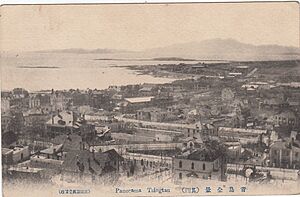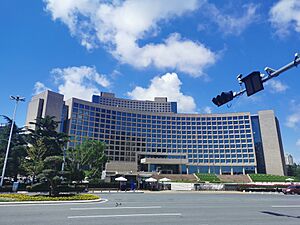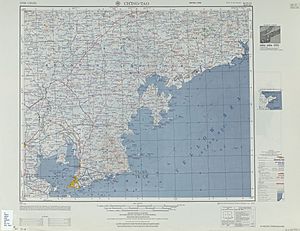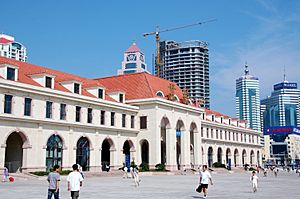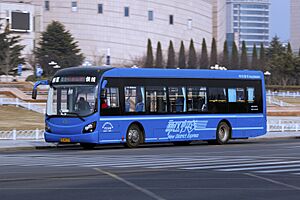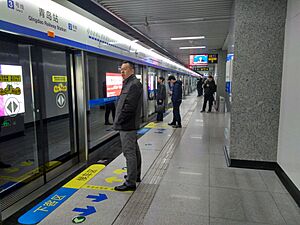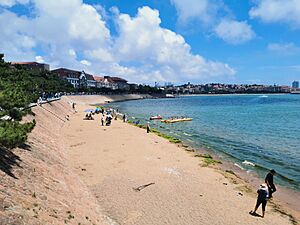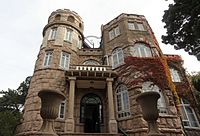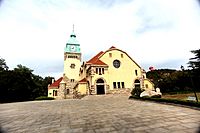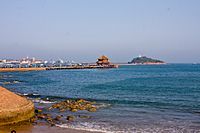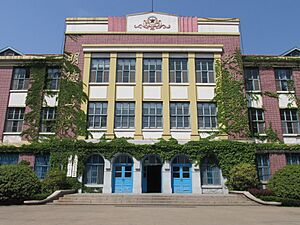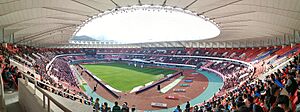Qingdao facts for kids
Quick facts for kids
Qingdao
青岛市
Tsingtao
|
|||||||||||
|---|---|---|---|---|---|---|---|---|---|---|---|
|
Prefecture-level and Sub-provincial city
|
|||||||||||
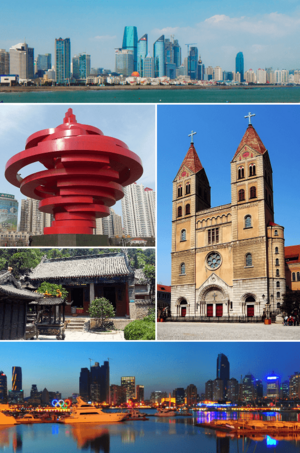
Clockwise from top left: Qingdao's skyline, St. Michael's Cathedral, Qingdao harbor, a temple at the base of Mount Lao, and May Fourth Square
|
|||||||||||
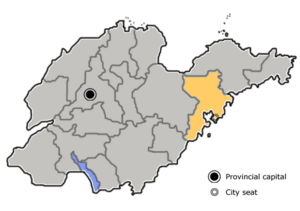
Location of Qingdao City jurisdiction in Shandong
|
|||||||||||
| Country | China | ||||||||||
| Province | Shandong | ||||||||||
| Lease to Germany | 6 March 1898 | ||||||||||
| Japanese occupation | 7 November 1914 | ||||||||||
| Return to China | 10 December 1922 | ||||||||||
| Japanese Occupation | 10 January 1938 | ||||||||||
| Return to China | 15 August 1945 | ||||||||||
| Municipal seat | 11, Xianggang Middle Rd, Shinan District | ||||||||||
| Government | |||||||||||
| • Type | Sub-provincial city | ||||||||||
| • Body | Qingdao Municipal People's Congress | ||||||||||
| Area | |||||||||||
| • Prefecture-level and Sub-provincial city | 11,228.4 km2 (4,335.3 sq mi) | ||||||||||
| • Land | 11,228.4 km2 (4,335.3 sq mi) | ||||||||||
| • Urban | 5,171.4 km2 (1,996.7 sq mi) | ||||||||||
| • Metro | 5,171.4 km2 (1,996.7 sq mi) | ||||||||||
| Population
(2020 census)
|
|||||||||||
| • Prefecture-level and Sub-provincial city | 10,071,722 | ||||||||||
| • Density | 896.986/km2 (2,323.184/sq mi) | ||||||||||
| • Urban | 7,172,451 | ||||||||||
| • Urban density | 1,386.946/km2 (3,592.17/sq mi) | ||||||||||
| • Metro | 7,172,451 | ||||||||||
| • Metro density | 1,386.946/km2 (3,592.17/sq mi) | ||||||||||
| GDP | |||||||||||
| • Prefecture-level and Sub-provincial city | CN¥ 1.200 trillion US$ 181.4 billion |
||||||||||
| • Per capita | CN¥ 128,459 US$ 19,412 |
||||||||||
| Time zone | UTC+8 (China Standard) | ||||||||||
| Postal code |
266000
|
||||||||||
| Area code(s) | 0532 | ||||||||||
| ISO 3166 code | CN-SD-02 | ||||||||||
| License Plate Prefix | 鲁B & 鲁U | ||||||||||
| Coastline |
|
||||||||||
| Major Nationalities | Han: 99.86% | ||||||||||
| County-level divisions | 10 | ||||||||||
| Climate | Dwa/Cwa | ||||||||||
|
|||||||||||
| Qingdao | |||||||||||||||||||||||||||||||||||
|---|---|---|---|---|---|---|---|---|---|---|---|---|---|---|---|---|---|---|---|---|---|---|---|---|---|---|---|---|---|---|---|---|---|---|---|

"Qingdao" in Simplified (top) and Traditional (bottom) Chinese characters
|
|||||||||||||||||||||||||||||||||||
| Chinese name | |||||||||||||||||||||||||||||||||||
| Simplified Chinese | 青岛 | ||||||||||||||||||||||||||||||||||
| Traditional Chinese | 青島 | ||||||||||||||||||||||||||||||||||
| Postal | Tsingtao | ||||||||||||||||||||||||||||||||||
| Literal meaning | "Qing (color) Island" | ||||||||||||||||||||||||||||||||||
|
|||||||||||||||||||||||||||||||||||
| German name | |||||||||||||||||||||||||||||||||||
| German | Tsingtao | ||||||||||||||||||||||||||||||||||
Qingdao (pronounced ching-DOW) is a large city in eastern Shandong Province, China. It sits on China's Yellow Sea coast. The city was started in 1891 to help protect the coast.
Qingdao is a very important seaport and naval base. It is also a big center for business and money. Famous electronics companies like Haier and Hisense are based here. The Jiaozhou Bay Bridge connects the main city area with Huangdao district.
The city has a unique look because of its historic German-style buildings. The famous Tsingtao Brewery is also a reminder of the time when Germany controlled the area. Qingdao is known as a major port city around the world.
In 2020, Qingdao was named a "Gamma+" global city. This means it's an important city that connects with the rest of the world. It's also one of the top 50 cities globally for scientific research. Qingdao has several important universities, including the Ocean University of China.
Contents
History of Qingdao
Ancient Times
People have lived in the Qingdao area for about 6,000 years. Ancient cultures like Dawenkou and Longshan lived here. During the Eastern Zhou dynasty, the town of Jimo was founded. It was the second-largest town in the Shandong region back then. The area was called Jiao'ao in 1891 by the Qing Dynasty.
German and Japanese Control

In 1891, the Qing Empire started building defenses in Qingdao. German naval officers watched this activity. In 1897, German missionaries were attacked, and two were killed. German troops then took over the area.
The Qing Empire had to give the area to Germany in 1898. This area was called the Kiautschou Bay concession. It lasted from 1898 to 1914. Qingdao was its main center.
When the Germans took control, Qingdao was a small fishing village. They built wide streets, strong houses, and government buildings. They also added electricity, a sewer system, and clean drinking water. This was very rare in Asia at that time.
The area had many schools, from primary to vocational. These schools were paid for by the German government and missions. The Germania Brewery, which later became Tsingtao Brewery, was started in 1903.
Qingdao was an important port for the German navy. Their East Asia Squadron was based here. This allowed German warships to operate in the Pacific Ocean.
- Siege of Tsingtao
- 10 sen (1914)
During World War I (1914–1918), Japan attacked Qingdao. Japanese troops took over the city in the Siege of Tsingtao. This happened after Japan declared war on Germany. China protested, but could not stop the fighting.
After World War I, the Paris Peace Conference decided not to return Qingdao to China right away. This angered many Chinese people. It led to the May Fourth Movement in 1919. This movement was about Chinese nationalism and cultural identity.
Qingdao returned to Chinese rule in December 1922. It was controlled by the Republic of China. However, Japan still had a lot of economic power in the region. The city became a special municipality in 1929.
Japan took over Qingdao again in 1938. This was during the Second Sino-Japanese War. Chinese forces returned after Japan surrendered in 1945. On June 2, 1949, the Chinese Red Army took Qingdao. Since then, the city has been under the control of the People's Republic of China.
City Development Over Time
German Era (1898–1914)
Qingdao's development began with its port. Major construction started in 1898. Wharves, the Tsingtao-Jinan Railway, and a railway station were built. The city started to take shape. The Germans also planned the city's layout. Sun Yat-sen, a leader of the Chinese Revolution, visited in 1912. He said, "The city is a true model for China's future."
First Japanese Era (1914–1922)
City development continued under Japanese control. Tsingtao became a base for using natural resources. A "New City District" was built for Japanese settlers. This area had modern shops and homes. New schools, hospitals, and public buildings were also constructed.
ROC Rule (1922–1938)
This period saw great progress in Qingdao. The government built many villas near the beach. Public buildings and places for fun and sports were completed. By 1937, the city's population was 385,000. Qingdao became a popular holiday spot.
Second Japanese Era (1938–1945)
Japanese forces returned in 1938. They planned to build a "Greater Tsingtao." However, they didn't get to finish most of their plans. Only a few new structures and roads were built.
Modern Qingdao
After World War II, the US Navy used Qingdao as a base. In 1949, the Communist Party of China took control.
Since 1984, China has opened up to foreign trade. Qingdao has grown quickly into a modern port city. It is now the headquarters for China's northern navy fleet. In 1984, US Navy ships visited Qingdao. This was the first US port call to China in over 37 years.
Northern Qingdao is now a major manufacturing area. It has chemical processing, rubber, and heavy manufacturing. There is also a growing high-tech area. Many service companies are based in the city's southern district.
City Districts
Qingdao is a large city with special importance in China. It is known as "Island City." Qingdao has 7 districts and 3 county-level cities. These are like different parts of a big puzzle that make up the whole city.
The districts are:
- Shinan District
- Shibei District
- Huangdao District
- Laoshan District
- Licang District
- Chengyang District
- Jimo District
The county-level cities are:
- Jiaozhou City
- Pingdu City
- Laixi City
Three districts (Shinan, Shibei, Licang) form the main city area. They are on a peninsula on the east coast of Jiaozhou Bay. Chengyang is on the north coast, and Huangdao (Xihai'an) is on the west coast of the Yellow Sea.
Geography and Climate
Qingdao is on the southern coast of the Shandong Peninsula. It borders other cities like Yantai and Weifang. The city covers about 10,654 square kilometers. Most of the city is flat, but there are mountains nearby. The highest point is 1,133 meters above sea level. Qingdao has a long coastline, about 730 kilometers long. There are five rivers longer than 50 kilometers in the area.
Weather Patterns
Qingdao has a mild climate with four seasons. It's influenced by monsoons and ocean currents. This means it has characteristics of a humid continental and humid subtropical climate.
Winters are cool to cold and windy, but usually dry. The average temperature in January is 0.2°C. Summers are generally hot and humid, but extremely hot days are rare. The average temperature in August is 25.6°C.
Because it's on the coast, spring arrives later than in inland areas. Fall is milder. The water temperature reaches about 25°C in late August, so swimming is popular for a few months. The average yearly temperature is 13.3°C.
Sometimes, in summer, Qingdao's beaches get huge algal blooms. These are large amounts of green algae. When they break down, they can create a "rotten egg" smell.
| Climate data for Qingdao (1991–2020 normals, extremes 1951-2010) | |||||||||||||
|---|---|---|---|---|---|---|---|---|---|---|---|---|---|
| Month | Jan | Feb | Mar | Apr | May | Jun | Jul | Aug | Sep | Oct | Nov | Dec | Year |
| Record high °C (°F) | 12.9 (55.2) |
19.6 (67.3) |
21.5 (70.7) |
25.2 (77.4) |
34.2 (93.6) |
34.4 (93.9) |
38.9 (102.0) |
34.3 (93.7) |
33.2 (91.8) |
28.4 (83.1) |
22.1 (71.8) |
16.2 (61.2) |
38.9 (102.0) |
| Mean daily maximum °C (°F) | 3.4 (38.1) |
5.6 (42.1) |
10.0 (50.0) |
15.7 (60.3) |
21.1 (70.0) |
24.3 (75.7) |
27.6 (81.7) |
28.7 (83.7) |
25.8 (78.4) |
20.2 (68.4) |
12.8 (55.0) |
5.9 (42.6) |
16.8 (62.2) |
| Daily mean °C (°F) | 0.2 (32.4) |
2.1 (35.8) |
6.2 (43.2) |
11.6 (52.9) |
17.1 (62.8) |
20.8 (69.4) |
24.7 (76.5) |
25.6 (78.1) |
22.3 (72.1) |
16.6 (61.9) |
9.5 (49.1) |
2.7 (36.9) |
13.3 (55.9) |
| Mean daily minimum °C (°F) | −2.4 (27.7) |
−0.6 (30.9) |
3.4 (38.1) |
8.7 (47.7) |
14.1 (57.4) |
18.5 (65.3) |
22.7 (72.9) |
23.4 (74.1) |
19.5 (67.1) |
13.7 (56.7) |
6.7 (44.1) |
0.1 (32.2) |
10.7 (51.2) |
| Record low °C (°F) | −15.5 (4.1) |
−12.1 (10.2) |
−6.2 (20.8) |
−1.6 (29.1) |
6.1 (43.0) |
12.0 (53.6) |
13.6 (56.5) |
16.3 (61.3) |
10.1 (50.2) |
1.9 (35.4) |
−7.2 (19.0) |
−11.3 (11.7) |
−15.5 (4.1) |
| Average precipitation mm (inches) | 10.3 (0.41) |
15.7 (0.62) |
18.0 (0.71) |
34.0 (1.34) |
64.1 (2.52) |
70.7 (2.78) |
159.1 (6.26) |
159.6 (6.28) |
69.4 (2.73) |
35.5 (1.40) |
35.2 (1.39) |
14.8 (0.58) |
686.4 (27.02) |
| Average precipitation days (≥ 0.1 mm) | 2.8 | 4.0 | 4.6 | 6.5 | 7.7 | 8.7 | 11.6 | 10.9 | 7.2 | 5.3 | 5.2 | 3.6 | 78.1 |
| Average snowy days | 3.8 | 3.3 | 1.6 | 0.2 | 0 | 0 | 0 | 0 | 0 | 0 | 0.7 | 2.7 | 12.3 |
| Average relative humidity (%) | 63 | 65 | 65 | 67 | 71 | 82 | 86 | 82 | 71 | 64 | 64 | 63 | 70 |
| Mean monthly sunshine hours | 160.4 | 164.9 | 208.6 | 219.1 | 234.3 | 186.0 | 168.3 | 194.5 | 201.1 | 202.1 | 163.4 | 158.5 | 2,261.2 |
| Percent possible sunshine | 52 | 53 | 56 | 56 | 54 | 43 | 38 | 47 | 55 | 59 | 54 | 53 | 52 |
| Average ultraviolet index | 2 | 3 | 5 | 7 | 9 | 9 | 10 | 9 | 7 | 5 | 3 | 1 | 6 |
| Source 1: China Meteorological Administration | |||||||||||||
| Source 2: Weather China Weather Atlas (UV index) | |||||||||||||
People of Qingdao
| Historical population | ||
|---|---|---|
| Year | Pop. | ±% |
| 1913 | 58,000 | — |
| 1953 | 916,846 | +1480.8% |
| 1964 | 1,383,433 | +50.9% |
| 1982 | 4,227,594 | +205.6% |
| 1990 | 6,663,989 | +57.6% |
| 2000 | 7,494,194 | +12.5% |
| 2010 | 8,715,100 | +16.3% |
| 2020 | 9,499,800 | +9.0% |
| Population size may be affected by changes in administrative divisions. | ||
Qingdao has over 10 million residents. About 7.1 million people live in the main urban area. The city's birth rate is about 10.15 births per 1,000 people each year. Living standards in Qingdao are high. This is thanks to its strong economy and good wages.
There is a large Korean community in Qingdao. In 2009, about 100,000 Koreans lived, worked, or studied there. This makes Qingdao the second-largest Korean population center in China.
Qingdao's Economy
Qingdao's economy has grown very fast. In 2006, its economy grew by 18.9 percent. The city's total economic output (GDP) was 42.3 billion US dollars. This made it the top city in Shandong Province.
In 2006, the World Bank called Qingdao one of China's six "golden cities." This was based on its good investment climate. In 2018, Qingdao's GDP reached 1.2 trillion Chinese Yuan.
Qingdao is famous for Tsingtao Brewery. This company was started by Germans and British in 1903. It makes Tsingtao beer, which is China's most famous beer exported around the world. Qingdao is also home to Haier, a big home appliance maker, and Hisense, a major electronics company.
In 1984, the Chinese government made a part of Qingdao a special economic zone. This helped the city develop its industries very quickly. Qingdao has received a lot of money from foreign investors. Its port is a major hub for trade. Countries like South Korea and Japan have invested a lot in the city.
Qingdao also has about 50,000 acres of farmland. Its coastline is full of fish, shrimp, and other sea resources. The city is also good at generating electricity from wind power.
Industrial Areas
- Qingdao West Coast New District
- Qingdao Special Economic and Technological Development Area
- Qingdao Free Trade Zone
- Qingdao High-tech Industrial Zone
- Qingdao University Industrial Zone
Transportation in Qingdao
Roads
Qingdao has over 1,145 kilometers of roads. Nearly 500 kilometers are expressways. These expressways connect Qingdao to many other major cities in China.
Some important expressways that start or pass through Qingdao are:
- G15 Shenhai Expressway (from Shenyang to Haikou)
- G18 Rongwu Expressway (from Rongcheng to Wuhai)
- G20 Qingyin Expressway (from Qingdao to Yinchuan)
- G22 Qinglan Expressway (from Qingdao to Lanzhou)
Haiwan Bridge
On June 30, 2011, the Haiwan Bridge opened in Qingdao. It is the longest bridge over water in the world. The bridge is about 26.4 miles long. It connects Qingdao to Huangdao and Hongdao. This bridge cut the travel time between Qingdao and Huangdao by 30 minutes.
On the same day, the Jiaozhou Bay Tunnel also opened. This tunnel makes travel even easier for buses and cars.
Sea Travel
Qingdao has one of the busiest seaports in the world. It works with 450 ports in 130 countries. In 2003, the port handled over 100 million tons of cargo. By 2011, it was the world's sixth-busiest port by cargo volume.
Ferries connect Qingdao to Shimonoseki, Japan. There are also two ferry lines to South Korea: one to Incheon and one to Gunsan.
Air Travel
Qingdao Jiaodong International Airport is 39 kilometers from the city center. It has 13 airlines and 94 routes. Twelve of these routes are international. The airport opened on August 12, 2021. It replaced the older Qingdao Liuting International Airport.
Trains
Qingdao's railway system has grown a lot since the late 1990s. It is the starting point for high-speed rail lines to Jinan. Major train stations in Qingdao include Qingdao railway station and Qingdao North railway station.
High-speed trains can reach speeds of 300 km/h. They connect Qingdao to major cities like Beijing, Shanghai, and Jinan. The fastest train to Beijing takes less than 3 hours. Regular train lines connect Qingdao to many other Chinese cities.
Public Transportation
Qingdao has over 5,283 buses. Many of these use CNG. There are also 136 trolleybuses. You can use a special card called the Qingdaotong Card to pay for all public transport.
Most non-air-conditioned buses cost 1 yuan. The city's buses carry about 737 million passengers each year. There are also several taxi companies in Qingdao.
Metro System
Qingdao has a modern subway system. The government approved its construction in 2009. Line 3 was the first line to open in 2015.
The city plans to build 19 subway lines in total, covering 872 kilometers. As of 2023, seven lines are open. These include Line 1, Line 2, Line 3, Line 4, Line 8, Line 11, and Line 13. There are 146 operating stations. Many more lines are currently being built.
Tramway System
Qingdao also has a tram system in Chengyang District. It opened in 2016. The system currently has one tram line.
Culture and Architecture
Architecture
Qingdao has many buildings with a German style. This is amazing because German control only lasted 16 years. This mix of German and Chinese architecture gives Qingdao a special feel. People used to say Qingdao was a city of "red tiles green trees, blue sky, and blue sea." This describes its beautiful look. Many old foreign-style buildings are still well-preserved.
Language
During the German control, the German language was taught a lot. But after World War I, it mostly disappeared. The local people speak a special accent called Qingdao dialect. The city government is working to promote standard Mandarin. Most educated people can speak it. Many young people also learn English and can talk with foreigners.
Festivals
- Qingdao International Horticultural Exposition 2014: A big international fair held in the city.
- Qingdao International Beer Festival: Held every August or September since 1991.
Tourism in Qingdao
Qingdao is a popular place for tourists. It has a beautiful seaside and mild weather. You can find parks, beaches, sculptures, and unique German and modern buildings along the coast.
Popular Places to Visit
Western Shinan District
- Zhan Qiao (Pier): A famous pier stretching into the sea.
- Little Qingdao Isle: A small island with a lighthouse.
- Tian Hou Temple: A folk museum.
- Badaguan: An old area with German and Japanese architecture.
- Lu Xun Park: Named after a famous Chinese writer.
- Zhongshan Park: Named after Sun Yat-sen.
- Xiao Yu Shan: A small hill with great views.
- St. Michael's Cathedral: A large church with twin spires, built in 1934.
- Qingdao Aquarium: A place to see sea animals.
- Kiautschou Governor's Hall: The old office of the German governors.
- Xinhao Hill: A hill with a great view of the city.
- Photographs of Historic Eurasian Area
Eastern Shinan District
- May Fourth Square: A coastal plaza with a large sculpture.
- Tsingtao Brewery: You can visit the brewery where the famous beer is made.
- Zhanshan Temple: Qingdao's oldest Buddhist temple.
- Qingdao International Sailing Centre: Hosted the Olympic sailing events in 2008.
Laoshan District
- Lao Shan: A famous Taoist mountain about 40 km east of Qingdao. It has a Taoist retreat called Great Purity Palace.
- National Shilaoren Tourist Resort: A famous beach with a unique rock shaped like an old man.
- Xiaomaidao Park: A park with hills, a beach, and nice coastal views.
Education in Qingdao
Universities and Colleges
Qingdao has many universities. The Ocean University of China is very important for marine sciences. Qingdao University is also a well-known school. Other important universities include:
- China University of Petroleum
- Shandong University of Science and Technology
- Qingdao Agricultural University
- Qingdao Technical College
- Qingdao Binhai University
International Schools
- Korean International School of Qingdao
- Malvern College Qingdao
- Pegasus California School, Qingdao
- International School of Qingdao
- Qingdao Amerasia International School
- Qingdao No.1 International School
- Qingdao Oxford International College
- Yew Chung International School of Qingdao
- Belt & Road Collaborative Innovation College (BRCIC)
Secondary Schools
- Qingdao No. 2 High School
- Qingdao No. 58 School
- Qingdao No. 1 High School
- Qingdao No. 9 High School
- Qingdao No. 15 High School
- Qingdao No. 19 High School
Sports in Qingdao
Stadiums
- Guoxin Gymnasium (Qingdao city sports center)
- Yizhong Sports Center
- Qingdao Tiantai Stadium
- Hongcheng Stadium
2008 Olympic Games
Qingdao helped host the 2008 Summer Olympics. It held the Olympic Sailing competitions. These events took place at the Qingdao International Sailing Centre.
Sister Cities
Qingdao has 36 sister cities around the world. These are cities that have special friendly relationships with Qingdao.
| City | Country | Year of Agreement |
|---|---|---|
| Acapulco | 1985 | |
| Adelaide | 2014 | |
| Bilbao | 2004 | |
| Daegu | 1993 | |
| Faisalabad | 2021 | |
| Galway | 1999 | |
| Iloilo City | 2003 | |
| Klaipėda | 2004 | |
| Long Beach | 1985 | |
| Makassar | N/A | |
| Mannheim | 2016 | |
| Miami | 2005 | |
| Montevideo | 2004 | |
| Nantes | 2005 | |
| Nes Ziyyona | 1997 | |
| North Shore City | 2008 | |
| Odesa | 1993 | |
| Paderborn | 2003 | |
| Perm | 2003 | |
| Puerto Montt | 1999 | |
| Regensburg | 2009 | |
| Richmond | 2008 | |
| Saint Petersburg | 2006 | |
| Shimonoseki | 1979 | |
| Southampton | 1998 | |
| Velsen | 1998 | |
| Vila Velha | 2009 | |
| Wilhelmshaven | 1992 | |
| Yerevan | 2023 |
Images for kids
See also
 In Spanish: Qingdao para niños
In Spanish: Qingdao para niños



